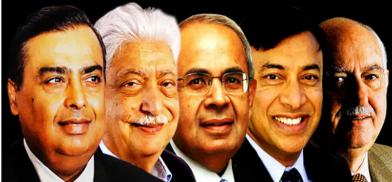Billionaire raj: Can India address its growing wealth disparity?
The massive and growing concentration of incomes is not good news for India's fragile social fabric as it can trigger a political backlash, writes N. Chandra Mohan for South Asia Monitor

India’s billionaires became richer while the vast majority of the population faced immiseration during the nationwide economic lockdown to combat COVID-19. While the economy entered into a recession, likely to contract by 7.7 percent this year, according to the first advance estimates of the National Statistical Office, the wealth of 100 billionaires increased by Rs. 12.97 trillion since March 2020.
However, 122 million people lost their livelihoods, the bulk of whom are daily wage earners engaged in construction, small enterprises, or street selling in the informal sector at risk of falling deeper into poverty. These startling numbers have been highlighted in the India supplement of Oxfam’s report. ‘The inequality Virus’ released on the opening day of the World Economic Forum’s Davos.
COVID deepens rising inequalities
Dialogues India’s experience is not very different from the worldwide pattern as the top 1,000 billionaire’s wealth rose by USD 3.9 trillion from March 18 to December 31, 2020 while the global economy faced its deepest recession in a century. Whether or not these trends shocked the conscience of A-listers who participated in the virtual Davos Dialogues, the pandemic has only worsened the existing inequalities in income.
India, for its part, has the “dubious distinction” of the largest number of billionaires per trillion dollars of gross domestic product. The ranks of millionaires and billionaires are growing every year, especially since the mid-1980s when the economic regime became more business–friendly with reforms.
Many of them have amassed wealth from land, real estate and natural resources due to proximity to government. This eliminates competition and slows growth. The frothy stock market boom during the coronavirus pandemic despite weak fundamentals further contributed to their accumulation of wealth.
The top one percent
Lucas Chancel and Thomas Piketty of the World Inequality Lab, Paris School of Economics, have used income tax returns and other data to assess trends in income disparities in India. In a paper ‘Indian Income Inequality 1922-2015: From British Raj to Billionaire Raj’ published in 2017, they observed a growing concentration of income among the top one percent of the population.
In fact, the share of national income accruing to the top one percent is the highest since the creation of the Income Tax Act in 1922! COVID-19 has only further exacerbated these widening disparities.
According to their work, during the 20th century, the share of top incomes followed a U-shape by being high in the 1920s and 1930s and then falling between 1950 and 1980 - largely due to economic regulations and high fiscal progressivity - and rising again in the era of reform.
The top one percent of earners captured less than 21 percent of national income in the late 1930s before dropping to 6 percent in the early 1980s and rising to 22 percent in the more recent period. The full brunt of this growing concentration has been felt by the bottom 50 percent and middle 40 percent incomes in the country.
The trend of growing disparities in India clearly follows the US pattern, where Chief Executive Officer (CEO) pay has widened substantially vis-a-vis the American worker’s income. This, in turn, had triggered a backlash like the Occupy Wall Street movement whose slogan is that we are the 99 percent in contrast to the top one percent who control a substantial fraction of national income.
A striking factoid of rising inequality is during the pandemic the wealth of India’s richest man, Mukesh Ambani, doubled to Rs. 5837 billion; that it would take 10,000 years for an unskilled worker to make what Ambani made in an hour.
Income concentration
While Chancel and Piketty explains the widening disparities of income as a by-product of economic growth, a recent paper by Varsha S Kulkarni and Raghav Gaiha ‘Beyond Piketty: A New perspective on poverty in India,’ Journal of Policy Modeling (2020) have explicitly drawn out the implications for worsening poverty outcomes.
According to their analysis, the widening gap between the income share of the top one percent and bottom 50 percent of the income distribution in India is associated with greater poverty. In other words, the growing millionaire and billionaire wealth does cause immiseration.
The massive and growing concentration of incomes is not good news for India's fragile social fabric as it can trigger a political backlash. This phenomenon has also eroded the tax base of the exchequer as these incomes escape the gaze of the taxman. From a sense of perspective, the money made by 100 billionaires during the pandemic can give Rs. 94,045 to each of the 138 million poorest people in the country.
The increase in wealth of even the top 11 billionaires can sustain the MGNREGS (Mahatma Gandhi National Rural Employment Guarantee Scheme) or the health ministry of India for the coming 10 years, according to Oxfam.
All eyes will be on the forthcoming fiscal budget for 2021-22, to be presented by Finance Minister Nirmala Sitharaman on February 1 in parliament, as to whether such incomes will be taxed to improve the lot of India's poor.
(The writer is an economics and business commentator based in New Delhi. His views are personal. He may be contacted at nchandramohan@rediffmail.com)










Post a Comment